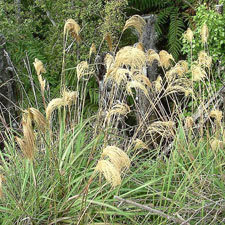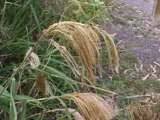 Himalayan fairy grass
Himalayan fairy grass
Common name:Himalayan fairy grass
Botanical name: Miscanthus nepalensis
Management programme: Sustained control - Rule 5a applies
Originates from South Africa. Brought to New Zealand as an ornamental garden plant and naturalised in 1952. Gardeners loved it for its ever-present flowers year round and hardiness. Can spread very easily by its fluffy seeds that are blown by wind.
Why is it a pest?
- Forms dense infestations, crowds out other plants and prevents native regeneration.
- Spreads readily from wind-blown seed and fragments of the roots.
- Develops extensive roots which make it hard to control.
Where is it found?
- Widely distributed throughout Bay of Plenty.
- Likes sunny roadsides, wasteland, disturbed areas, forest margins, open cliffs.
What does it look like?
- Tall tufted perennial grass to 1m high.
- Stiff leaf blades with rough margins.
- Golden brown, drooping fan-shaped flower head on a long stem.
- Similar looking plant to the native Chionchloa species.
- Flowers summer to autumn.
What are the rules?
Sustained control
Sustained Control pests are well established in the region and preventing the spread is no longer a realistic objective. Management focuses on reducing general impacts of the pest. Landowners/occupiers are responsible for the control of these pest species on their land. Council may enforce control.
Under rule 5a of the RPMP landowners/occupiers must destroy this pest if required by a written direction from an authorised person unless a property specific pest management agreement has been agreed and signed between the occupier and the Council.
Criteria to meet Rule 5A include when the species is being actively managed by council, other agency and or community group, on an adjacent property. See the Regional Pest Management Plan 2020-2030 rules for Sustained control pests for more information.
How do you get rid of it?
- Dig out (all year round) ideally in spring before flowering.
- Remove all flowers and seed heads safely before controlling and dispose of at a refuse transfer station.
- Avoid burning as that will increase its growth.
- Check site regularly for regrowth and seedlings.
CAUTION: When using any herbicide or pesticide, PLEASE READ THE LABEL THOROUGHLY to ensure that all instructions and directions for the purchase, use and storage of the product, are followed and adhered to.
Read more on pest control advice, information and regulations.
Images





